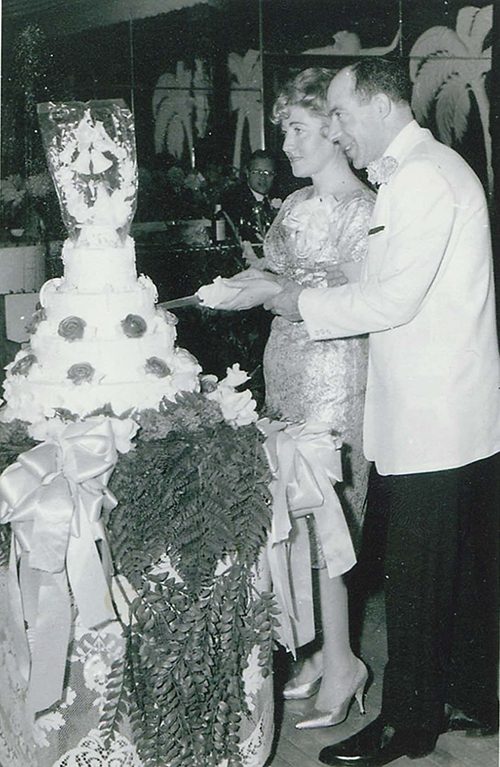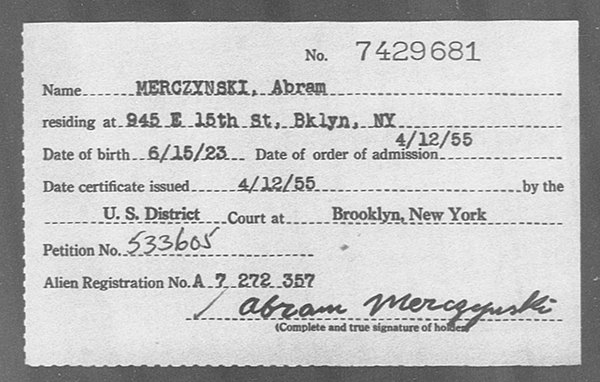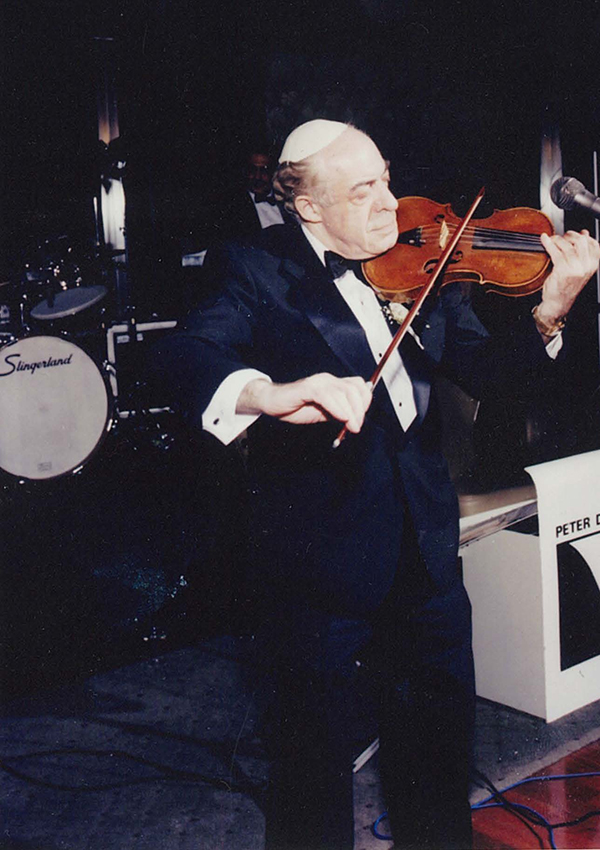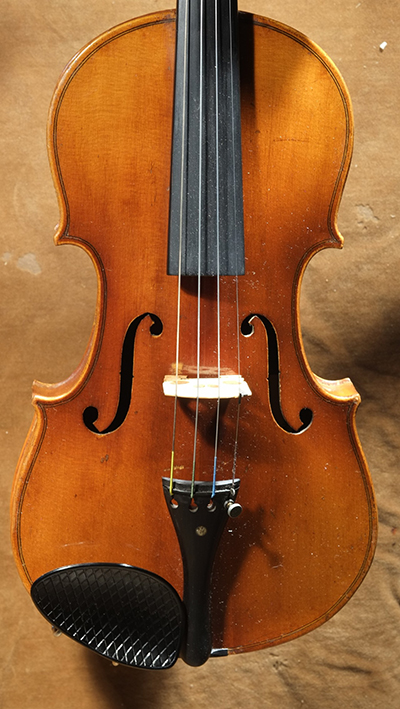When Abram Merczynski’s brother organized an orchestra in the Lodz ghetto, Abram promised himself that if he survived the war, he’d learn to play the violin. He lived—and kept his promise.
Photos and Artifacts

Post-war gathering with friends. Abram Merczynski is second from left. His brother Zysman is second from right, seated next to Pola, his future wife; Zysman and Pola later immigrated to Israel. At far right is Hillek Porway, a close family friend. Photo likely taken in Munich, Germany, 1946 or 1947. Credit: Courtesy of the Merczynski Family.

Abram and Miriam Merczynski at their wedding party in Brooklyn, New York, on May 5, 1962. Abram and Miriam got married in Israel in November 1961 and arrived in the U.S. in April 1962. To celebrate their union with those in New York who had been unable to attend the wedding in Israel, Abram organized this party as a surprise for Miriam, whom he’d told the party was for someone else. Credit: Courtesy of the Merczynski Family.

Abram Merczynski’s naturalization card, U.S. District Court for the Eastern District of New York, 1955. Credit: Courtesy National Archives; ID: 73273898.

The 4 surviving Merczynski brothers at the 1969 bar mitzvah of youngest brother Izzy's son, Steven. L to R: Izzy Merin, Abram Merczynski, Zysman Merczynski, and the oldest brother Benjamin "Yumo" Merchin on the right. (Izzy changed his last name to Merin and Benjamin "Yumo", who moved to France after the war, changed his last name to Merchin). Abram and Izzy worked together in Brooklyn. Izzy lived in Flushing, Queens. Abram lived in Manhattan, Brooklyn and Cedarhurst, Long Island. Zysman (prounounced Zeesmahn - sweetman in Yiddish) lived in Haifa, Israel, and "Yumo" lived in France. CREDIT: Courtesy of the Merczynski Family
By Dr. Samuel Kassow
Abram Merczynski was born on June 15, 1923, in Lodz, Poland, in the rundown Baluty neighborhood, which would later become the site of the Lodz ghetto. He was the third of six children—five boys and a sister who died in childhood. His parents, Shia and Etl, made a living selling animal feed.
When Abram was still a young boy, the family decided to move to a better section of town, and they set about building a new house on the outskirts of Lodz. No sooner had they started than the Great Depression began in 1929. Because they could not afford windows to keep out the cold, the family slept in the basement, which they shared with their horse. Hard times almost forced Shia to close his business and lose his new house. But he persevered and by the late 1930s, the family’s economic position had stabilized.
Abram’s parents followed Jewish tradition. The family observed the Sabbath and Jewish holidays. Like many other Jewish children in Lodz, Abram attended a Polish public school in the mornings and a Jewish religious school, or cheder, in the afternoons. (After the war, Abram admitted that he questioned his faith and the existence of God. But like many other survivors, he still insisted that his children receive a Jewish education; both his son and daughter attended the Flatbush Yeshiva in Brooklyn.)
Before the war, Lodz was the second biggest city in Poland—a sprawling, bare-knuckled industrial town of about 600,000 inhabitants, according to the 1931 census. It was a multinational city of Poles (59 percent), Jews (32 percent), and Germans (9 percent). Known as the “Polish Manchester” because of its large textile industry, Lodz was a city of contrasts, with huge palaces and appalling slums.
Lodz was a town that inspired important novels—Wladyslaw Reymont’s Promised Land in Polish, I.J. Singer’s The Brothers Ashkenazi in Yiddish—whose themes were strikingly similar: class friction, ethnic strife, the raw tension of unsparing capitalism. Both Reymont and Singer described the Lodzhermensch, a word that was the same in German and Yiddish. The Lodzhermenschen were the mostly German and Jewish entrepreneurs and hustlers who drove Lodz’s growth in the 19th century, who made and lost huge fortunes, started big factories, and sometimes burned them down to collect insurance. Some of the Lodzhermenschen turned into legendary businessmen, like Karl Scheibler—who was German—and Izrael Poznanski—who was Jewish—who endowed hospitals and churches and supported the arts.
Over time, Lodz also became a major cultural center, the home of great Yiddish and Hebrew writers, actors, and artists like Moshe Broderson, Yisroel Rabon, Shimon Dzigan, and Yitzhak Katzenelson. Julian Tuwim, a Lodz Jew who wrote in Polish, is remembered as one of Poland’s greatest poets of the last century. Artur Rubinstein was born in the city. Many Lodz intellectuals and artists came to love their raw, unfinished town. They took a perverse pride in its newness and lack of tradition.
The Germans captured Lodz on September 8, 1939, and immediately began a reign of terror, with the avid participation of much of the city’s large German population, who immediately turned on their Polish and Jewish neighbors. There were roundups and shootings of the Jewish and Polish intelligentsia. German soldiers and civilians barged into Jewish homes and businesses and looted to their heart’s content. The city’s most beautiful synagogues went up in smoke. Nonetheless, right up until the final deportation in 1944, Abram’s father refused to believe that the “civilized” Germans he remembered from the First World War could be capable of planned mass murder.
In November 1939, the Nazis annexed Lodz and the surrounding region to the German Reich, as part of the Warthegau province headed by the notorious Gauleiter Arthur Greiser. The SS made immediate plans to deport all of Lodz’s 160,000 Jews to the Generalgouvernement, the administrative entity for German-occupied central Poland run by Hans Frank. However, soon after these deportations began in late 1939, Frank loudly protested to Hitler that he did not want his turf to turn into a dumping ground for Jews. Hitler sided with Frank, and for the time being the Jews stayed in Lodz, where they were forced to enter a ghetto that was sealed on April 30, 1940.
The Germans assumed that the ghetto would be a temporary arrangement, and that with the fall of France in June 1940, they would be able to ship all the Lodz Jews to Madagascar. But when Britain stayed in the war, those plans fell through. Ironically, the Lodz ghetto, one of the first to be established, was the last ghetto to be liquidated; it lasted until August 1944.
A key reason why the ghetto survived as long as it did is that its Nazi-appointed Jewish boss, Chaim Rumkowski, succeeded in convincing key Germans that Lodz, with its large reservoir of skilled workers, could become a major center of war production for the German economy. Indeed, by 1943 (by which time the ghetto’s population had been culled to 70,000), there were 117 factories and enterprises in the ghetto, including the communications equipment shop where Abram worked. The ghetto generated enormous profits, and many Nazi officials eagerly lined their pockets. SS plans to liquidate the ghetto in 1943 ran aground against the opposition of Greiser and Albert Speer, Hitler’s armaments czar.
Meanwhile, plans were underway to rid the ghetto of those who did not contribute. Deportations to Chelmno, the first death camp that the Nazis established, began in January 1942, when 20,000 Jews—mostly welfare cases and people whom Rumkowski did not like—were sent to die in Chelmno’s gas vans. The ghetto’s remaining German and Czech Jews were deported in May of that year, by which time Rumkowski probably knew what awaited deportees to Chelmno.
One of the most traumatic weeks in the Lodz ghetto’s existence occurred in September 1942, when all the Jews were forced into a multi-day lockdown while the Germans seized all children under the age of 10, elderly Jews, and those deemed too weak to work. (The children of Jewish police and high ghetto officials were exempt.) Rumkowski, in a tearful speech, told the Jews to “hand over your children.” Only by sacrificing the children and the weak was it possible to buy time, he warned. If they did not cooperate, the Germans would destroy the entire ghetto. Parents looked on in helpless despair as the Germans went from building to building, armed with lists, and took away their young sons and daughters. Unlike some other major ghettos, such as the one in Warsaw, the Lodz ghetto was largely sealed off from the outside world. Over the course of four long years, not one pistol was smuggled into the ghetto, and not one messenger from the outside managed to penetrate the German cordon. There were no recorded incidents of armed resistance, despite Lodz’s proud tradition of revolutionary defiance against Russian rule before 1914.
Whereas about 90 percent of the food consumed in the Warsaw ghetto was smuggled in, the Jews in Lodz depended entirely on the German food allocations. Those who worked in a shop might receive 1,400 calories a day. Those who did not work got considerably less. Food, therefore, became the major obsession in the ghetto. People starved—some slowly, some more quickly. Parents went hungry to save food for their children; others became so demoralized that they began to steal food from their loved ones.
Over time, about a quarter of the Jews in the Lodz ghetto succumbed to starvation or disease. On the other hand, there were ways of getting by, as Abram’s testimony shows. The Merczynski family serves as a key example of how family solidarity and hustle could make it possible to survive. Abram cultivated a small plot of land, a privilege probably obtained through personal connections. The family traded their rations for sugar, which they used to distill alcohol, and then sold the home brew for a profit, which they exchanged for food.
It was no surprise that power in the ghetto flowed into the hands of those who distributed food and decided on who got what. As a result, Lodz, unlike Warsaw, was a highly regimented ghetto. There were hardly any private shops and there was no network of autonomous social institutions. Rumkowski, along with his minions, ruled the ghetto like a dictatorship, favoring those he liked and brutally punishing those who crossed him. He enjoyed the trappings of power, and many, perhaps most, Jews in the ghetto hated him. Even so, they respected his ability to negotiate with the Germans, to set up new factories, and, above all, to buy time.
Like most Judenrat leaders, Rumkowski was a tragic figure. He saw himself as a messianic savior, with a God-given mission to rescue as many Jews as possible, even if he had to sacrifice others to do so. When he could, he helped the ghetto’s children, procured extra food rations for them, set up schools, and handed out small welfare stipends to the neediest Jews. But when the Germans demanded victims, he went along, arguing that there was no other choice. One virtue of Abram’s testimony is that he understood the complexity of judging Rumkowski and the fraught game that he was trying to play. Like many other survivors of the Lodz ghetto, Abram wondered if he would have remained alive had it not been for Rumkowski.
The end of the Lodz ghetto came in August 1944. Lodz was by now the last ghetto standing and the Russians were only 60 miles away. The wily German chief of the ghetto, Hans Biebow, assured all the Jews, including Rumkowski, that they would be deported for labor in Germany. But the trains all went to Auschwitz. One of Abram’s brothers suffocated on the journey there. At Auschwitz, about two-thirds of the surviving Jews, including Rumkowski and Abram’s mother, were sent to the gas chambers. The remaining Jews—including Abram, his surviving brothers, and his father—were sent to concentration camps in Germany.
Because Lodz was the last ghetto to be liquidated, it had the most Jewish survivors. A total of 200,000 Jews passed through the ghetto, including refugees deported from the Reich, the Protectorate, and the provincial towns that surrounded Lodz. About 43,000 died of disease and starvation, and 80,000 were deported to Chelmno. During the final liquidation, 70,000 were deported to Auschwitz, of whom 20,000 were selected for labor. Of these, between 7,000 and 10,000 survived the war.The worst time for Abram came at Kaufering, the concentration camp where he, his father, and brothers were deported from Auschwitz. Kaufering was part of the Dachau camp system and consisted of 11 different Lagers set up near Landsberg in 1944 to build bomb-proof tunnels for the manufacture of fighter planes. Most of the 30,000 prisoners who passed through the Kaufering camps were Jews from Hungary, Lithuania, Poland, and elsewhere. Only 50 percent lived to see the liberation. It was a measure of the Reich’s growing desperation that Hitler himself approved the introduction of Jewish slave laborers into Germany, just two years after the Nazis proudly proclaimed that the Reich was judenrein. As Abram mentioned in his testimony, the backbreaking labor that killed so many of the Jewish prisoners was all for naught. Not one plane was ever built at Kaufering.
Abram also described the terrible conditions in the camp. Some of the worst sadists of the SS were assigned to Kaufering at the end of the war, as their previous camps closed down in the face of the Russian advance. Disease spared no one. Abram himself contracted typhus and dysentery. He also mentioned the brutality of the Kapos, the Jewish prisoners who were empowered by the Germans to keep order in the camp. He ran into one after the war in America but realized that vengeance would give him no satisfaction; as with Rumkowski, he again noted that the battle for survival leads people to do things that defy easy judgment.
Life in Kaufering was so intolerable that one of Abram’s brothers tried to hang himself and survived only because another prisoner cut him down at the last minute. Meanwhile, Abram tried to help his father, but they were in different barracks and he could only watch helplessly as his father wasted away and died. As was the case in many other Nazi camps in April 1945, many prisoners died in the final week before liberation—the victims of death marches, train bombings, and last-minute SS killing sprees. At Kaufering, Max Blanke, the head SS doctor, set alight barracks that housed sick inmates, and many were burned alive just before the Americans arrived.
But Abram survived, as did three of his four brothers. After the war, while living in Munich, he immediately began his journey back to life. He set his sights on a visa to the United States. And he also fulfilled a long-held wish to study the violin—a yearning that began in the Lodz ghetto, where one of his brothers had organized an orchestra that provided a small measure of pleasure and beauty for the beleaguered Jews. Abram got himself a violin, found a teacher, and devoted himself to learning to play the instrument. It was a passion that he cultivated until the end of his life.
Abram arrived in the United States in 1949. One brother went to Israel, another to France, and a third, Izzy, followed Abram to the U.S. Together with Izzy and some other survivors, Abram started a successful company called A.M. Knitwear that sold women’s sweaters to major department store chains.
In 1961 Abram went to Israel for his nephew’s bar mitzvah and met Miriam, a native of Vilna who had survived the war in Russia. They fell in love and married in November 1961. They had a daughter, Eleanor, born in 1963, and a son, Steven, born in 1966.
Abram shared his love of music with his children and his four grandchildren. For a long time he was bothered by nightmares about the camps. But as time went on, he became convinced that he had a sacred obligation to let others know about what he and his family had endured.
———
Additional readings and information
Abram’s unedited testimony at the Fortunoff Video Archive (available at access sites worldwide): https://fortunoff.aviaryplatform.com/collections/5/collection_resources/1787.
Dobroszycki, Lucjan, ed. The Chronicle of the Lodz Ghetto, 1941-1944. New Haven, CT: Yale University Press, 1984.
Kassow, Samuel, ed. In Those Nightmarish Days: The Ghetto Reportage of Peretz Opoczynski and Josef Zelkowicz. Translated and co-edited by David Suchoff. New Haven, CT: Yale University Press, 2015.
Rosenfarb, Chava. The Tree of Life: A Trilogy of Life in the Lodz Ghetto. Translated by the author in collaboration with Goldie Morgentaler. Madison, WI: University of Wisconsin Press, 2005.
Trunk, Isaiah. Lodz Ghetto: A History. Translated and edited by Robert Moses Shapiro. Bloomington, IN: Indiana University Press, 2006.
###


